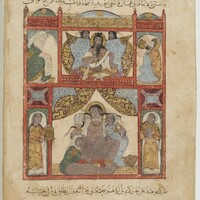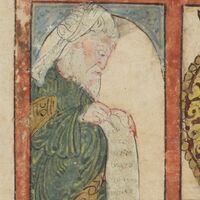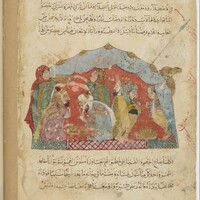Maqamat of al-Wasiti
Type:
Illuminated manuscripts
Date:
1237
Location or Findspot (Modern-Day Country):
Iraq
Medium:
Parchment
Dimensions:
37 × 28 cm
Description:
The Maqamat (Assemblies) are tales written in rhyming prose interspersed with poetry. An illustrated copy made in Baghdad in 1237 is a compilation of fifty of these stories collected together by Muhammad al-Qasim ibn Ali al-Hariri (1054–1122). According to the colophon, this thirteenth-century copy was written and illustrated by Yahya bin Mahmud al-Wasiti. The narrator of the Maqamat is a traveling merchant named al-Harith and the hero is a clever rogue named Abu Zayd.
The Maqamat of al-Wasiti contains a depiction of Muslim burial, ostensibly in the town of Saweh (Iran). This illustration on fol. 29v accompanies maqama 11, in which al-Harith goes to meditate in a cemetery and witnesses a burial. Readers of the book also view the Muslim burial scene, with two large, domed mausolea behind a simpler tomb in the foreground. Witnesses of both sexes observe the interment of the shrouded body while a man at lower right holds up a lamp, presumably indicating a nighttime setting. A shovel and a basket for earth are on the ground before him. While the men are placid, the women's reactions are more dramatic, including figures who tear their hair and clothes in grief. They are probably professional mourners, hired for the occasion to advertise the status of the deceased (this practice was common in many ancient and medieval places, including China, Iran, Greece, and Italy, and continues in some settings today). The deceased will be placed in the tomb on his right side, with his face toward Mecca.
On fol. 122v, a woman gives birth in the presence of a midwife and her maidservants. An astrologer seated in the top right confers with an astrolabe to time the exact moment of the birth and ascertain the child's future or temperament. In the top left, Abu Zayd writes an amulet that will be tied in silk and fastened to the woman's leg to protect her and the child during and after the birth.
In addition to professional mourners, midwives, and maidservants, there are women in al-Wasiti's illustrations fulfilling a range of other roles. On fol. 58v, Abu Zayd is in a mosque, standing on a minbar preaching to a group of men. Women watch from a separate, upper register. On fol. 139v, female attendants serve a meal.
Relevant Primary Sources
The Maqamat of al-Wasiti contains a depiction of Muslim burial, ostensibly in the town of Saweh (Iran). This illustration on fol. 29v accompanies maqama 11, in which al-Harith goes to meditate in a cemetery and witnesses a burial. Readers of the book also view the Muslim burial scene, with two large, domed mausolea behind a simpler tomb in the foreground. Witnesses of both sexes observe the interment of the shrouded body while a man at lower right holds up a lamp, presumably indicating a nighttime setting. A shovel and a basket for earth are on the ground before him. While the men are placid, the women's reactions are more dramatic, including figures who tear their hair and clothes in grief. They are probably professional mourners, hired for the occasion to advertise the status of the deceased (this practice was common in many ancient and medieval places, including China, Iran, Greece, and Italy, and continues in some settings today). The deceased will be placed in the tomb on his right side, with his face toward Mecca.
On fol. 122v, a woman gives birth in the presence of a midwife and her maidservants. An astrologer seated in the top right confers with an astrolabe to time the exact moment of the birth and ascertain the child's future or temperament. In the top left, Abu Zayd writes an amulet that will be tied in silk and fastened to the woman's leg to protect her and the child during and after the birth.
In addition to professional mourners, midwives, and maidservants, there are women in al-Wasiti's illustrations fulfilling a range of other roles. On fol. 58v, Abu Zayd is in a mosque, standing on a minbar preaching to a group of men. Women watch from a separate, upper register. On fol. 139v, female attendants serve a meal.
Relevant Primary Sources
Relevant Textbook Chapter(s):
8
Repository and Online Resources:
• See the entire manuscript on the website of the Bibliothèque nationale de France.
• Visit the Schoenberg Institute for Manuscript Studies' website for Islamic Manuscript Basics.






